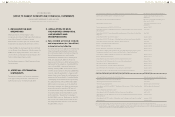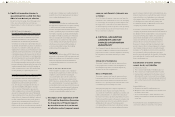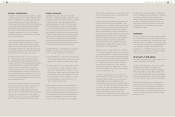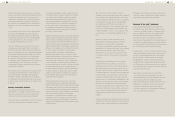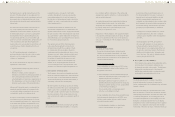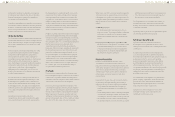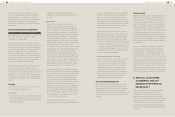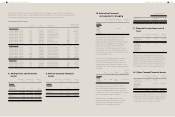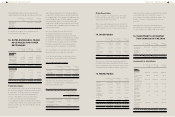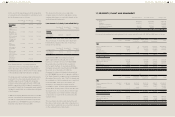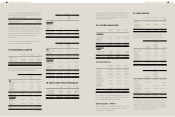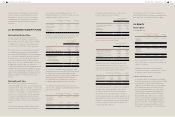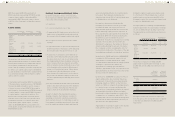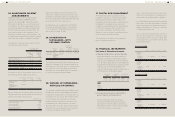HTC 2013 Annual Report Download - page 102
Download and view the complete annual report
Please find page 102 of the 2013 HTC annual report below. You can navigate through the pages in the report by either clicking on the pages listed below, or by using the keyword search tool below to find specific information within the annual report.
FINANCIAL INFORMATION FINANCIAL INFORMATION
200 201
The estimates and underlying assumptions are
reviewed on an ongoing basis. Revisions to
accounting estimates are recognized in the period
in which the estimate is revised if the revision affects
only that period, or in the period of the revision and
future periods if the revision affects both current and
future periods.
The following are the key assumptions concerning
the future, and other key sources of estimation
uncertainty at the end of the reporting period,
that have a significant risk of causing a material
adjustment to the carrying amounts of assets and
liabilities within the next financial year.
a. Accrued marketing and advertising
expenses
The Company recognizes sale of goods as the
conditions are met. For information on the
principles of revenue recognition, please refer to
Note 4 "revenue recognition" section. The related
marketing and advertising expenses recognized as
reduction of sales amount or as current expenses
are estimated on the basis of agreement, past
experience and any known factors. The Company
reviews the reasonableness of the estimation
periodically.
As of December 31, 2013, December 31, 2012 and
January 1, 2012, the carrying amounts of accrued
marketing and advertising expenses were
NT$19,328,804 thousand, NT$15,531,875 thousand
and NT$25,556,956 thousand, respectively.
b. Allowances for doubtful debts
Receivables are assessed for impairment at the
end of each reporting period and considered
impaired when there is objective evidence that,
as a result of one or more events that occurred
after the initial recognition of the receivables, the
estimated future cash flows of the asset have
been affected.
As of December 31, 2013, December 31, 2012
and January 1, 2012, the carrying amounts of
As of December 31, 2013, December 31, 2012
and January 1, 2012, the carrying amounts of
inventories were NT$18,463,656 thousand,
NT$20,521,967 thousand and NT$25,389,320
thousand, respectively.
f. Realization of deferred tax assets
Deferred tax assets should be recognized only to
the extent that the entity has sufficient taxable
temporary differences or there is convincing other
evidence that sufficient taxable profit will be
available. The management applies judgment and
accounting estimates to evaluate the realization
of deferred tax assets. The management takes
expected sales growth, profit rate, duration of
exemption, tax credits, tax planning and etc. into
account to make judgment and estimates. Any
change in global economy, industry environment
and regulations might cause material adjustments
to deferred tax assets.
As of December 31, 2013, December 31, 2012
and January 1, 2012, the carrying amounts of
deferred tax assets were NT$6,475,936 thousand,
NT$6,545,718 thousand and NT$5,359,291
thousand, respectively.
g. Estimates of warranty provision
The Company estimates cost of product
warranties at the time the revenue is recognized.
The estimates of warranty provision are on
the basis of sold products and the amount of
expenditure required for settlement of present
obligation at the end of the reporting period.
The Company might recognize additional provisions
because of the possible complex intellectual
product malfunctions and the change of local
regulations, articles and industry environment.
As of December 31, 2013, December 31, 2012
and January 1, 2012, the carrying amounts of
warranty provision were NT$6,391,787 thousand,
NT$6,780,712 thousand and NT$12,755,264
thousand, respectively.
allowances for doubtful debts were NT$3,050,907
thousand, NT$2,059,086 thousand and
NT$1,554,008 thousand, respectively.
c. Impairment of tangible and intangible
assets other than goodwill
The Company measures the useful life of individual
assets and the probable future economic benefits
in a specific asset group, which depends on
subjective judgment, asset characteristics and
industry, during the impairment testing process.
Any change in accounting estimates due to
economic circumstances and business strategies
might cause material impairment in the future.
The recoverable amount of intangible assets is
less than its carrying amount. The Company
recognized impairment loss on intangible assets
other than goodwill for NT$111,085 thousand for
the year ended December 31, 2013.
d. Impairment of goodwill
Test of impairment on goodwill depends on
the subjective judgment of management. The
management uses subjective judgment to
identify cash-generating units, allocates assets
and liabilities to cash-generating units, allocates
goodwill to cash-generating units, and determines
recoverable amount of a cash-generating unit.
The Company determined that the recoverable
amount of goodwill in 2012 was less than
its carrying amount and thus recognized an
impairment loss on goodwill for NT$45,017
thousand for the year ended December 31, 2012.
e. Valuation of inventories
Inventories are measured at the lower of cost or
net realizable value. Judgment and estimation
are applied in the determination of net realizable
value at the end of reporting period.
Inventories are usually written down to net
realizable value item by item if those inventories
are damaged, have become wholly or partially
obsolete, or if their selling prices have declined.
6. CASH AND CASH EQUIVALENTS
December 31,
2013
December 31,
2012
January 1,
2012
Cash on hand $1,010 $1,010 $1,000
Checking
accounts
15,209 4,562 7,903
Demand
deposits
9,305,095 29,544,930 21,844,352
Time deposits
(with original
maturities less
than three
months)
23,713,190 12,995,427 31,544,315
$33,034,504 $42,545,929 $53,397,570
Cash equivalents include time deposits that have a
maturity of three months or less from the date of
acquisition, are readily convertible to a known amount
of cash, and are subject to an insignificant risk of
change in value; these were held for the purpose of
meeting short-term cash commitments.
The market rate intervals of cash in bank at the end of
the reporting period were as follows:
December 31,
2013
December 31,
2012
January 1,
2012
Bank deposits 0.20%-0.85% 0.20%-1.05% 0.15%-1%
7. FINANCIAL INSTRUMENTS AT
FAIR VALUE THROUGH PROFIT
OR LOSS
December 31,
2013
December 31,
2012
January 1,
2012
Financial assets
held for trading
Derivatives (not
designated
as hedging
instruments)
Exchange
contracts
$162,297 $6,950 $256,868



